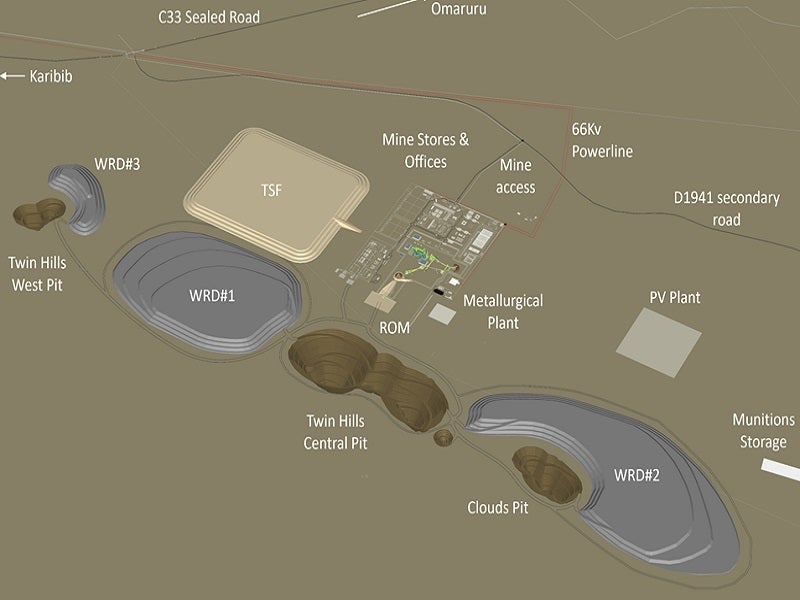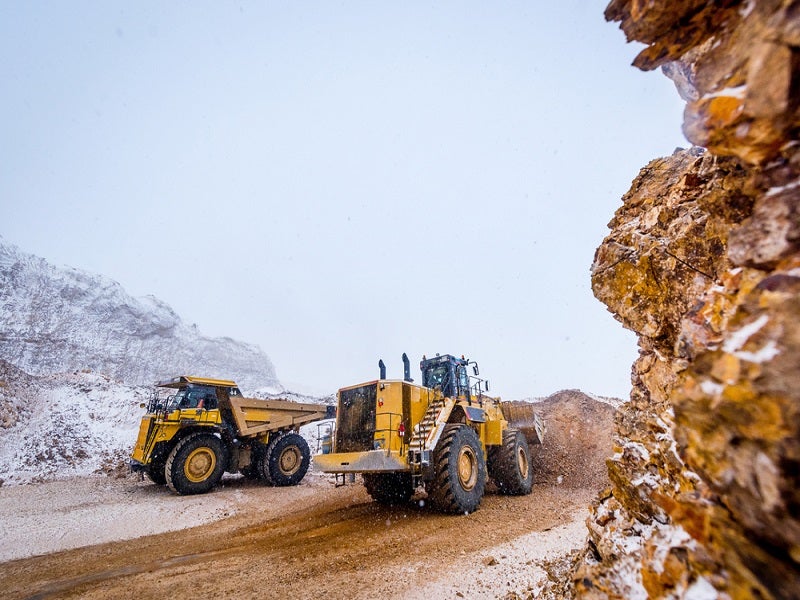The Twin Hills gold project, located in Namibia, South Africa, is being developed by Osino Resources, a gold exploration and development company based in Canada.
The pre-feasibility study (PFS) for the project was completed in September 2022. The life of the mine (LoM) is expected to be 13 years, with average annual gold production of 200,000oz for the first four years and 169,000oz for the remaining LoM.
The project is expected to require an investment of $375m. The Namibian Ministry of Environment, Forestry and Tourism granted the project an Environmental Clearance Certificate in January 2023.
The definitive feasibility study (DFS) for the project is currently ongoing and is expected to be completed by mid-2023.
Location
The Twin Hills gold project is located in central Namibia, 20km from the nearby town of Karibib and 150km from Windhoek, the capital city, in the Erongo region.
The project is situated 5km from the sealed national highway system and 220km from Walvis Bay, a modern seaport that serves as the primary logistics port for the mining industry.
Geology and mineralisation
The project is located to the east-northeast of the Navachab gold mine in the southern central section of the Damara belt, and to the south of a significant regional Omaruru lineament. The area is characterised by the presence of homogenous syntectonic granite of the Salem type in the north-eastern portion.
Mineralisation at the Twin Hills property occurs in a meta-greywacke unit composed of massive and interbedded units. Within the greywackes, mineralisation occurs parallel to the axial plane of the tightly folded package and is associated with shearing at the deposit level.
Gold mineralisation is closely associated with arsenopyrite occurring in millimetre-scale veinlets and fine-grained disseminates.
Proven and probable reserves
The total proven and probable reserves at the mine are estimated at 64.3 million tonnes (mt), containing 2.15 million ounces (Moz) of gold grading 1.04g/t.
Mining at Twin Hills gold project
A conventional open-pit mining method comprising drilling and blasting along with standard truck and shovel operations will be used at the Twin Hills gold project. Drilling and blasting will be performed on 10m-high benches.
The waste benches will be mined using a bulk-mining technique, with face shovels to load the whole 10m bench, while backhoe excavators will be used to load the mineralised benches in two 5m flitches to reduce ore loss and dilution.
The mine consists of seven pits, including Central Twin Hills, Bulge pit, Clouds, Clouds West, Twin Hills North, Kudu, and Oryx pits, which will be mined in seven pushbacks over the LoM.
The mine fleet will include a 130t hydraulic backhoe shovel for selective loading, while 250t hydraulic face shovels will be employed to load 10m benches. Off-highway rigid haul trucks with a 100t capacity will be used for haulage.
The ore and waste will be loaded by hydraulic excavators and carried by diesel-powered vehicles to the processing plant, tailings storage and landfill.
The rest of the fleet will comprise support equipment such as graders, track and wheel dozers, front-end loaders, rock breakers and utility excavators.
Processing capacity
The Twin Hills process facility will have a nameplate ore capacity of five million tonnes per annum (Mtpa) and a nominal capacity of 649 tonnes per hour (tph). It will use three-stage crushing, ball milling, and carbon-in-leach (CIL) and filtration circuits.
The processing plant will include primary and secondary cone crushers with a throughput capacity of 815tph. A high-pressure grinding roll unit (HPGR) will serve as a tertiary crusher. The ball mill and cyclone classification circuit can process 5Mtpa of ore and will produce a leach feed of 63 micron.
The concentrate will be leached and electrowinned, then a portion of the cyclone underflow will be gravity-concentrated to recover liberated gold. A traditional CIL circuit made up of seven leach-adsorption tanks will be used, followed by a cyanide destruction circuit.
Elution circuits, electrowinning cells and smelting are used to recover and refine gold and produce gold doré. A gold recovery rate of 93.2% is expected for the first six years, and a rate of 92% for the remaining LoM.
Supporting infrastructure
The project is easily accessible through Namibia’s national rail and road network.
Osino has signed an agreement with national power utility NamPower to connect the project to the national power grid. A high-voltage overhead powerline will be built to connect the site switchyard to the grid.
The company also proposes to develop a 20MW solar photovoltaic power plant that will supply 25% of the project’s power requirements. The design and development of the solar power plant is currently ongoing.
Water for the project will be drawn from groundwater borehole pumping, the Karibib wastewater scheme supply, Okawayo flood attenuation dam and the NamWater scheme.
Contractors involved
Lycopodium Minerals Canada, an engineering consultant, prepared the PFS report for the Twin Hills gold project and is also preparing the DFS.
The project’s technical report was prepared by CSA Global South Africa, a mining consultant and subsidiary of ERM Group Company.
Orway Mineral Consultants, a company based in Australia, was contracted to prepare the processing plant design.






